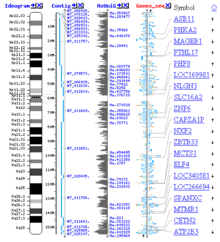
Back معلوماتية حيوية Arabic معلوماتيه حيويه ARZ Bioinformatika Azerbaijani Біяінфарматыка Byelorussian Биоинформатика Bulgarian জৈব তথ্যবিজ্ঞান Bengali/Bangla Bioinformatika BS Bioinformàtica Catalan زیندەزانیارییەکان CKB Bioinformatika Czech


Bioinformatics (/ˌbaɪ.oʊˌɪnfərˈmætɪks/ ⓘ) is an interdisciplinary field of science that develops methods and software tools for understanding biological data, especially when the data sets are large and complex. Bioinformatics uses biology, chemistry, physics, computer science, computer programming, information engineering, mathematics and statistics to analyze and interpret biological data.[1] The subsequent process of analyzing and interpreting data is referred to as computational biology.
Computational, statistical, and computer programming techniques have been used for computer simulation analyses of biological queries. They include reused specific analysis "pipelines", particularly in the field of genomics, such as by the identification of genes and single nucleotide polymorphisms (SNPs). These pipelines are used to better understand the genetic basis of disease, unique adaptations, desirable properties (esp. in agricultural species), or differences between populations. Bioinformatics also includes proteomics, which tries to understand the organizational principles within nucleic acid and protein sequences.[2]
Image and signal processing allow extraction of useful results from large amounts of raw data. In the field of genetics, it aids in sequencing and annotating genomes and their observed mutations. Bioinformatics includes text mining of biological literature and the development of biological and gene ontologies to organize and query biological data. It also plays a role in the analysis of gene and protein expression and regulation. Bioinformatics tools aid in comparing, analyzing and interpreting genetic and genomic data and more generally in the understanding of evolutionary aspects of molecular biology. At a more integrative level, it helps analyze and catalogue the biological pathways and networks that are an important part of systems biology. In structural biology, it aids in the simulation and modeling of DNA,[3] RNA,[3][4] proteins[5] as well as biomolecular interactions.[6][7][8][9]
- ^ Gagniuc P (17 August 2021). Algorithms in Bioinformatics: Theory and Implementation (1 ed.). Wiley. pp. 1–528. ISBN 978-1-119-69796-1.
- ^ Lesk AM (26 July 2013). "Bioinformatics". Encyclopaedia Britannica. Archived from the original on 14 April 2021. Retrieved 17 April 2017.
- ^ a b Sim AY, Minary P, Levitt M (June 2012). "Modeling nucleic acids". Current Opinion in Structural Biology. 22 (3): 273–8. doi:10.1016/j.sbi.2012.03.012. PMC 4028509. PMID 22538125.
- ^ Dawson WK, Maciejczyk M, Jankowska EJ, Bujnicki JM (July 2016). "Coarse-grained modeling of RNA 3D structure". Methods. 103: 138–56. doi:10.1016/j.ymeth.2016.04.026. PMID 27125734.
- ^ Kmiecik S, Gront D, Kolinski M, Wieteska L, Dawid AE, Kolinski A (July 2016). "Coarse-Grained Protein Models and Their Applications". Chemical Reviews. 116 (14): 7898–936. doi:10.1021/acs.chemrev.6b00163. PMID 27333362.
- ^ Wong KC (2016). Computational Biology and Bioinformatics: Gene Regulation. CRC Press/Taylor & Francis Group. ISBN 978-1-4987-2497-5.
- ^ Joyce AP, Zhang C, Bradley P, Havranek JJ (January 2015). "Structure-based modeling of protein: DNA specificity". Briefings in Functional Genomics. 14 (1): 39–49. doi:10.1093/bfgp/elu044. PMC 4366589. PMID 25414269.
- ^ Spiga E, Degiacomi MT, Dal Peraro M (2014). "New Strategies for Integrative Dynamic Modeling of Macromolecular Assembly". In Karabencheva-Christova T (ed.). Biomolecular Modelling and Simulations. Advances in Protein Chemistry and Structural Biology. Vol. 96. Academic Press. pp. 77–111. doi:10.1016/bs.apcsb.2014.06.008. ISBN 978-0-12-800013-7. PMID 25443955.
- ^ Ciemny M, Kurcinski M, Kamel K, Kolinski A, Alam N, Schueler-Furman O, et al. (August 2018). "Protein-peptide docking: opportunities and challenges". Drug Discovery Today. 23 (8): 1530–1537. doi:10.1016/j.drudis.2018.05.006. PMID 29733895.
© MMXXIII Rich X Search. We shall prevail. All rights reserved. Rich X Search